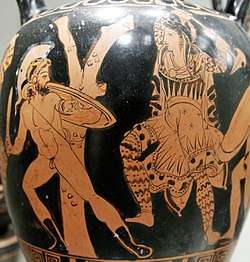Gigantomachy by the Suessula Painter
The gigantomachy by the Suessula Painter is a painting on a red-figure amphora from the Classical period of Greece. It is the work of the "Suessula Painter", an Athenian vase-painter whose name is unknown. He worked in both Corinth and Athens and is recognizable by his style, with great freedom of posture and a unique shading of figures. This red-figure amphora was made around 410-400 BCE and is 69.5 cm tall, 32 cm large. It is currently conserved in the Louvre Museum.
| Red-figure Amphora | |
|---|---|
 Another Vase of the Suessula Painter, depicting an Amazonomachy | |
| Material | Ceramic |
| Created | -425 to -375 BC |
| Present location | Metropolitan Museum of Art New York |
The Gigantomachy
This vase is separated in registers, with the largest register being the only one decorated with mythological scenes one encircling the belly of the amphora is the only one decorated with mythological scenes, the one below is empty and the one above is simply covered in floral motives. The interesting thing about this vase is the difference between the side A and B. Both are a representation of the Gigantomachy, the fight between the Giants, Gaïa's sons and the Olympian gods, accompanied by Herakles. The first side is much more elaborated than the second one, and it led specialists to believe that it might be a reproduction of the Gigantomachy of Phidias depicted inside the shield of the Parthenon Athena.[1] On the side A, we can see Zeus ready to hit a Giant identified as Porphyrion [2] with his lightning bolt, next to Nike on a chariot run by horses, while Dionysus' chariot one is run by panthers. Poseidon is on the same side, on the back of a horse. Athena and Herakles – with his leonte, the skin of the lionof Nemea, that he had to kill for his first labor – are fighting side by side, under Nike's carriage. Around them, and recognizable by their varying attributes are Apollo, Artemis and Hermes. They all are fighting giants, recognizable by the fact that they are not wearing any kind of clothes. On the side B, which, as it is not as intricate as the side A, and was interpreted as a filling of the other side, a reproduction of the shield, we can see the rest of that Gigantomachy scene, with Ares and Aphrodite on a chair in the middle. Demeter, Persephone, Hekate and the Dioskouroi are also present and fighting the giants.
To fully understand the meaning of that vase painting, it is necessary to place it back in its context. It was made by an Athenian artist in the Vth century, at the peak of the Athenian imperialism over the Greek world, afer they both won the Greco-Persian wars and took control of the treasury of theDelian League. During that time, the High Classical Period, representations of Gigantomachy, Centoromachy or amazonomachy were quite common. Those depictions of the Olympian Gods triumphing over lesser, or foreigner societies were used as a metaphor of the Athenian victory over the Persians, and their now supremacy over Greece.[3]
Bibliography
- Martine Denoyelle, Chefs d'oeuvre de la céramique grecque dans les collections du Louvre, 1994, Éditions de la Réunion des musées nationaux, p. 154, n 72
- Devambez, "L'Amazone de l'amphore de la Gigantomachie au Louvre et le bouclier de la Parthénos", Mélanges Orlandos, 1964, pp. 102-9, pl. 28, 29
Notes
- "L'Amphore de la Gigantomachie de Milo au Musée du Louvre" by Pierre Devambez in Comptes rendus des séances de l'Académie des Inscriptions et Belles-Lettres Année 1963 Volume 107 Numéro 3 pp. 282-284
- Jane Henle, Greek Myths, A Vase Painter’s Notebook (Bloomington; Indian University Press, 1973), p. 47.
- "On Iconology, Intention, Imagos, and Myths of Meaning" by Seymour Howard in Artibus et Historiae, Vol. 17, No. 34 (1996), pp. 83-94